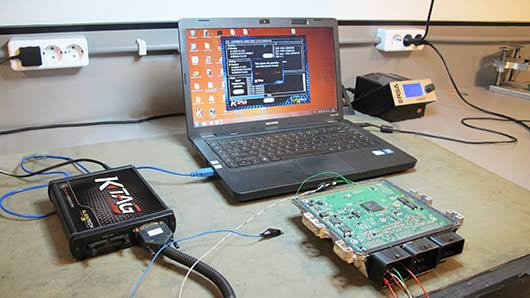Ever wondered how race cars seem to defy physics, squeezing out every last drop of horsepower? The secret weapon in their arsenal might surprise you: it's not just about fancy engines and lightweight bodies.
ECU tuning plays a crucial role in unlocking the hidden potential within a car's engine. But what exactly is ECU tuning, and how does it work? Buckle up, gearheads, because we're about to take a deep dive into the world of engine control unit optimization.
What is ECU Tuning?
Imagine your car's engine as a complex symphony. The Engine Control Unit (ECU) acts as the conductor, constantly monitoring and adjusting various engine parameters like fuel injection, ignition timing, and boost pressure to maintain optimal performance and meet emission standards. ECU tuning essentially involves modifying these parameters within safe limits to achieve specific goals, such as increased power, improved fuel efficiency, or sharper throttle response.
How Does ECU Tuning Work?
The ECU relies on software maps containing pre-programmed settings for various engine functions. Tuners use specialized tools and software to access and modify these maps, tailoring them to specific performance objectives. Think of it like adjusting the dials on a mixing board – a slight tweak here, a fine adjustment there, and the entire engine symphony transforms.
Learning the Art of ECU Tuning:
ECU tuning isn't magic; it's a science backed by knowledge and experience. Here are some paths to becoming an ECU tuning pro:
- Formal Training: Several automotive training programs and workshops delve into ECU tuning principles and practical application.
- Online Resources: A plethora of online tutorials, forums, and communities offer valuable insights and knowledge sharing from experienced tuners.
- Start with the Basics: Before diving into complex modifications, solidify your understanding of engine operation, fuel injection systems, and ignition timing.
The Stages of ECU Tuning:
ECU tuning isn't a one-size-fits-all process. The complexity and modifications involved can be categorized into stages:
- Stage 1 Tuning: This is often the most accessible stage, typically involving minor adjustments to boost pressure, fuel delivery, and ignition timing for a noticeable performance gain without extensive modifications.
- Stage 2 Tuning: As the name suggests, this stage builds upon Stage 1, often incorporating hardware upgrades like performance air intake systems or exhaust modifications alongside further ECU adjustments.
- Stage 3 Tuning: Strap yourselves in! Stage 3 ventures into serious performance territory, often involving significant hardware upgrades like turbocharger modifications, high-performance camshafts, and a complete ECU remap to optimize the engine for maximum power.
Performance vs. Everyday Driving:
While the allure of horsepower might be tempting, remember that ECU tuning for peak performance often comes at a cost. Fuel efficiency might decrease, emissions might increase, and the engine may require more frequent maintenance. Consider your driving habits and prioritize the type of performance you desire – raw power or a balance between efficiency and responsiveness.
ECU Tuning Software and Tools:
Think of ECU tuning software as the conductor's sheet music. It provides a visual representation of the engine maps and allows tuners to make precise adjustments. These software programs often work in conjunction with specialized hardware tools that connect to the car's ECU to read and write data.
ECU Tuning Files and Their Secrets:
The modified software maps created during ECU tuning are commonly referred to as "ECU tuning files." These files essentially contain the new "instructions" for the ECU to optimize engine performance. The specific content of these files can vary depending on the tuning stage and desired outcomes.
A Glimpse into the Tuning File:
Imagine a complex spreadsheet with rows and columns representing various engine parameters like RPM range, throttle position, and load. The values within these cells are meticulously adjusted by tuners to achieve the desired performance characteristics. However, It's important to understand that providing a direct sample of an ECU tuning file is discouraged for a few reasons:
- Security: ECU tuning files can be considered proprietary information by tuning companies. Sharing them could be a copyright violation.
- Complexity: These files are often complex and not easily interpretable by someone without extensive ECU tuning knowledge. A raw data dump wouldn't be very informative.
- Specificity: ECU tuning files are highly specific to a particular car model, engine type, and tuning stage. A generic sample wouldn't be applicable to most readers' situations.
Here's what we can offer as an alternative:
Structure Example: We can describe the general structure of an ECU tuning file. Imagine a large table with rows and columns. The rows might represent different engine RPM ranges (e.g., 1000 RPM, 2000 RPM, etc.), while the columns might represent various engine parameters like:
- Throttle Position (%)
- Engine Load (%)
- Boost Pressure (psi)
- Air-Fuel Ratio
- Ignition Timing (degrees)
Sample Adjustments: We can illustrate how tuners might modify specific values within the file. For instance, in a Stage 1 tune for increased power, a tuner might slightly increase boost pressure values at higher RPM ranges and adjust the air-fuel ratio for a richer mix to support more power.
By understanding the general structure and potential adjustments made in ECU tuning files, you gain valuable insight without revealing sensitive information.
ECU tuning, when done correctly, can unlock a car's hidden potential. But remember, with great power comes great responsibility! Always prioritize safe tuning practices, understand the potential trade-offs, and consult with experienced professionals to ensure optimal performance and engine longevity. Happy tuning!

Comments (0)
Please login to join the discussion
Be the first to comment on this article!
Share your thoughts and start the discussion